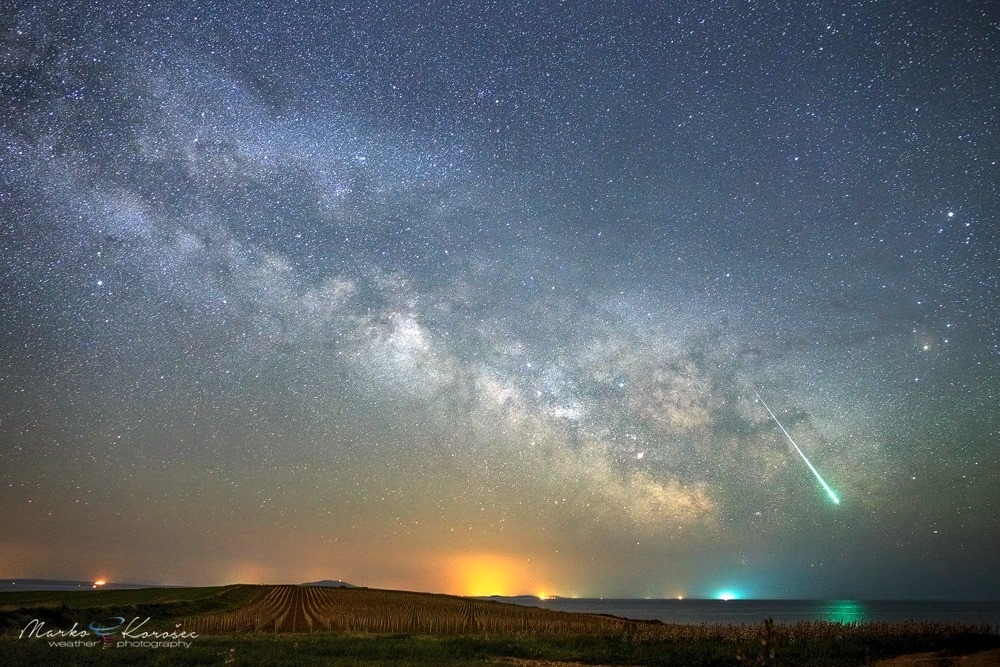Here comes the first meteor shower of the spring: the Lyrids. This moderate meteor shower brings a nice celestial display to the spring night skies. Here is what the Lyrids are and when and how to see them.
The Lyrids are crumbs of comet C/1861 G1 (Thatcher). It is a lump of icy dirt that completes one As it rounds the Sun, the ices within the comet sublimate and release trapped clumps of mineral grains. As these particles, now called meteoroids, spread along the comet’s orbit, a meteoroid stream forms. When the Earth passes through a meteoroid stream, numerous meteoroids impact our atmospheres, producing flashes of light – meteors. Thus a meteor shower forms. It gets its name from the location of its radiant – the point from which meteors appear to radiate. For the Lyrids the radiant is in – Lyra.
A brilliant Lyrid fireball shoots down the Milky Way. Note the reflection in the sea. Photo: Marko Korošec / Weather-photos.net
A spotted record
The historic record is spotted with strong returns of the Lyrid meteor shower. As far back as 687 B.C., Chinese astronomers spotted a strong return of the Lyrids. Additional strong showers were seen in 15 B.C. and 1136 A.D., when Korean chronicles note that “many stars flew from the northeast”. The first well-observed Lyrid outburst was in 1803: there were so many Lyrids that people of Richmond, Virginia were alarmed at the spectacle unfolding in the sky. As many as 500-1000 meteors per hour could be seen! That is about ten times as strong as the Perseid meteor shower! Additional strong returns with over 100 meteors per hour were seen in 1922, 1945 and 1982.
What to expect in 2019
A normal return of the Lyrids is expected this year. No enhanced activity is currently expected. Under a dark sky that would mean about 10-15 Lyrid meteors per hour. Unfortunately, a waning gibbous Moon (86% full) will rise in late evening, around 11:30 pm, and brighten the sky considerably. Bright moonlight hides fainter meteors, so only brighter ones can be seen. This reduces the overall number of visible meteors. Fortunately the Moon is in the constellation Ophiuchus and remains low in the sky, particularly for observers at higher northern latitudes. The sky will thus still be significantly less bright than if the Moon was higher.
When and how to see the Lyrids
The best time to see the Lyrids will be evening hours of April 22 and early morning hours of April 23. As the Lyrid prime time in the final predawn hours will be affected by the bright Moon the most, the alternative is to make the best of the darker evening hours. The radiant will be lower and fewer Lyrids will appear in the sky, however, you will be able to see fainter Lyrids that will be hidden by moonlight later. Expect a moderate show with a Lyrid appearing every 5 to 10 minutes. You can also expect a sporadic (non-shower) meteor every once in a while, probably one every 10 minutes or so. It will not be a full-blown fireworks display, like with the Perseids or the Geminids, rather a steady trickle of meteors.
It is easy to find the Lyrid radiant. After twilight look towards the east. The brightest white star in that part of the sky is Vega, the brightest star of constellation Lyra. The radiant will be some 10° higher up: make a fist and extend your hand – the radiant is one width of your fist above Vega. The Lyrids can appear anywhere in the sky, but if you backtrack their paths, all will converge in the radiant. The Lyrids are medium fast meteors, slower than the popular summer Perseids.
Good luck with your observations!
There is more
While you are at it, you can try photographing the Lyrids!
And here are other meteor showers to watch this year:
2019 meteor shower calendar – which meteor showers to see this year
